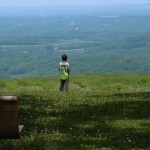 The natural beauty of the north country, diverse wildlife, assorted recreational opportunities and unique geology make Blue Mound State Park in Wisconsin a very special place. Visitors come year-round.
The natural beauty of the north country, diverse wildlife, assorted recreational opportunities and unique geology make Blue Mound State Park in Wisconsin a very special place. Visitors come year-round.
Blue Mound State Park, opened in 1959, is just north of Blue Mounds village, 25 miles west of Madison. It comprises 1,153 acres at the juncture of two geological regions: the Southwest Savanna and the Western Coulee and Ridges.
In summer, the park is a popular Wisconsin swimming destination. Cross-country skiers, snowshoers and sledders enjoy the firm, white terrain in winter. The park lures picnickers, hikers, campers and cyclists (including mountain bikers) much of the year. In every season, it’s an ideal place for an individual, family or group to retreat and rejuvenate.
Two 40-foot observation towers and scenic overlooks reveal the surrounding beauty. Orientation devices atop the towers point to Wisconsin cities and geological sites of interest. Visitors view beautiful bluffs and the Lower Wisconsin River Valley.
The park maintains a sheltered picnic area with a playground, sandboxes and horseshoe court. It also has a vista and amphitheater, which are popular for group gatherings, reunions and weddings. Campsites are available.
Blue Mound’s Wildlife
Extensive park trails bring visitors face-to-face with floral splendor, which changes constantly. They also meet some of the many forest creatures.
White-tailed deer are common and are not bashful. They frequently are seen around the swimming pool and other public areas. In summer, visitors delight to study gangling fawns under the watchful eyes of their mothers.
Ground squirrels, raccoons, chipmunks and woodchucks abound. More evasive are the park’s population of badgers, coyotes, flying squirrels, shrews, foxes, weasels, cottontails, skunks, opossums, moles, bats and mice. Many species are nocturnal and thus are rarely seen.
Blue Mound State Park is treasured by birders. At least 75 nesting bird species have been identified. A small sampling: scarlet tanagers, wood pewees, flycatchers, catbirds, towhees, grosbeaks, grouse, vireos, owls, chickadees, warblers, blue jays, large pileated woodpeckers and wild turkeys. Turkey vultures and hawks ride the air currents high above the park. Even in winter, as many as 25 species of birds may be seen.
The park’s catalog of plant life is equally diverse. Spring, naturally, is the best time to enjoy Blue Mound State Park’s floral beauty: blooming bloodroot, violet, buttercup, dogwood, cherry, toothwort, yellow lady’s slipper and many other species. Hikers and picnickers in summer and autumn frequently encounter “sticky” plants—enchanter’s nightshade, agrimony, sweet cicely and burdock. Color during those seasons is added by prairie grasses, goldenrods, sunflowers, blazing stars and black-eyed Susans. Maple and other hardwood leaves blanket the park in beautiful autumn shades.
The Unusual Geology of Blue Mound State Park
The park is situated on a dolomitic limestone mound. It is one of several geological mounds in the Driftless Area.
Granite forms the deep bedrock of Wisconsin mounds. Over a period of 2 billion years, nature altered the scene from mountains to sea bed to the present “mound” classification. Ancient sands and sediments became sandstone and limestone. Blue Mound and other mounds in the area have been partially preserved from centuries of erosion because they are capped by Niagara dolomite, a hard, durable mineral.
During the glacial period, the mounds of modern-day Wisconsin withstood the glaciers that encroached and flattened land as far south as Kansas. Basically, they stood preserved as “glacial islands.” Geologists now refer to the region as the Driftless Area because it contains none of the rock and soil accumulations, or “drift,” the melting glaciers left in their aftermath.
Interesting Facts About Blue Mound State Park
* It is situated at the highest elevation in the southern part of the state and is Wisconsin’s seventh-highest locale. At its summit, it is 1,716 feet above sea level.
* Millions of years ago, the area was at the bottom of what geologists have named the Silurian Sea.
* The mound encompasses different “microclimates.” As a consequence, spring blooming occurs notably earlier on trees and flowers in the southwestern part of the park.
Park staff and volunteers regularly stage naturalist presentations and other educational and recreational programs. Special events during the year include an annual campout and seasonal attractions such as the Candlelight Ski.
For details about Blue Mound State Park, visit the Wisconsin Department of Natural Resources Web site [http://www.dnr.state.wi.us/org/land/parks/specific/bluemound] or phone (608) 437-5711.